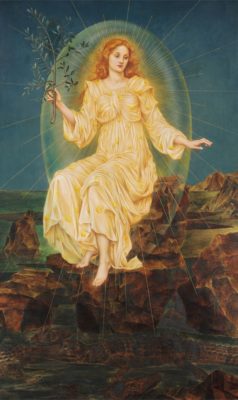By Sarah Hardy, Director of the De Morgan Museum
Evelyn De Morgan’s 1895 picture ‘Lux in Tenebris’ takes its Latin title from “Light in Darkness”, setting the tone for the entire composition. The painting shows a radiant, ethereal figure emerging from the inky depths in a halo of bright light. She wears a robe embroidered with tiny flames of gold into which the artist has worked gold paint to make the painting shine. At the bottom of the composition is a swamp brimming with crocodiles, whose gnarled heads emerge from the murky waters.
As fireworks light up the night sky at this time of year, we are reminded of De Morgan’s figure shining bright from the darkness. This illuminating figure represents a number of different meanings through the rich tapestry of meanings woven into the painting.

Lux in Tenebris (1895)
One intriguing aspect of ‘Lux in Tenebris’ is its potential Christian undertones. The title itself echoes the Christian concept of divine light dispelling darkness, with Jesus being referred to as the “Light of the World.” The painting can be seen as an allegory for spiritual illumination and redemption.
The late 19th century was marked by a surge in spiritualism, a movement focused on communicating with spirits and exploring the unseen world of the departed. De Morgan’s painting captures this fascination by portraying the ethereal figure, possibly representing spirits or souls. It alludes to a connection between the material and spiritual realms with the very realistic crocodiles, representing the monstrous reality of the physical world.
These ancient and powerful creatures can symbolise primordial forces and hidden aspects of the human psyche. The crocodiles may represent the challenges and dangers one must navigate on the path to spiritual enlightenment, echoing the idea that true illumination often involves confronting inner demons.
A closer look at this painting reveals that the artist changed the symbolic meaning of the piece. The female figure originally held a flaming torch aloft before De Morgan covered it with an olive branch. The flaming torch traditionally symbolises enlightenment, knowledge, and illumination. In the context of the painting, a torch would have represented the quest for spiritual or intellectual enlightenment. It might suggest a more active and even aggressive pursuit of knowledge, with fire symbolising the transformative power of light, possibly a reference to Greek mythology and the story of the mortal Prometheus who stole fire from the gods and gave it to humanity. As punishment, Zeus ordered Prometheus to be tied to Mount Caucasus, where every day an eagle devoured his liver, which was restored during the night. This grim tale was captured by Briton Riviera in his 1889 painting ‘Prometheus’ (below). Riviera’s depiction of the fall of night, and the coming of relief, was exhibited at the Grosvenor Gallery in 1889 with a quotation from Elizabeth Barrett Browning’s translation of Aeschylus: ‘Night shall come up with garniture of stars to comfort thee with shadow.’ This represents hope in the darkest hour.
The olive branch, on the other hand, has a very different symbolism. It is associated with peace, reconciliation, and harmony. In ancient Greece, the olive branch was a symbol of goodwill and the end of conflict, and it is also famously associated with the story of Noah’s Ark in the Bible, where a dove brought back an olive leaf to signify the end of the flood. In the context of ‘Lux in Tenebris,’ the olive branch might be interpreted as a representation of a peaceful and harmonious path to enlightenment.
This change in the object held by the female figure in De Morgan’s picture alters the message from one of active pursuit and aggressive seeking of enlightenment to a more tranquil and harmonious quest. The olive branch conveys the idea that the emergence of light is a peaceful and reconciliatory process, emphasizing the harmonious coexistence of different elements, even in the face of darkness. The painting becomes a meditation on the possibility of finding light and spiritual enlightenment through peace and unity rather than through conflict or force. It reflects a shift from a more assertive, aggressive stance to a gentler, more spiritually attuned perspective.



